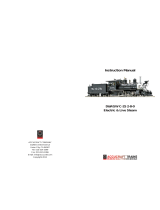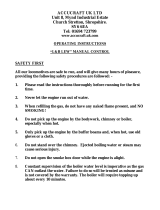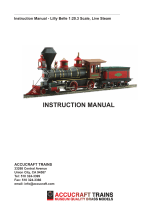Page is loading ...

ACCUCRAFT COMPANY
33268 Central Avenue
Union City, CA 94587
Tel: 510-324-3399
Fax: 510-324-3366
Copyright 2013
Instruction Manual
D&RGW K-37
LIVE STEAM

Instruction Manual D&RGW K-37 Live Steam
Prototype Information
The K-37’s were originally built as standard gauge 2-8-0’s by Baldwin in 1902
Ten of these engines were converted to narrow gauge between 1928 to 1930
by the D&RGW. New chassis were created, and the boilers and tenders were
used over again on the narrow gauge versions. D&RGW numbered these
engines 490 to 499, and most survive today on display. These engines were
not as popular as the K-36’s. The reason for this was the K-36 was easier on
the crews and the track as well. However in model form the K-37 is the largest
locomotive that can be built in 1:20.3 scale The huge boiler allows runs of
well over an hour without ever injecting water. This new Live Steam version is
also cross ported so that valve gear is in prototypical position for forward and
reverse. This large model is extremely powerful , but unlike the prototype is
very easy and rewarding to run.
1
NOTES:
Instruction Manual D&RGW K-37 Live Steam

Instruction Manual D&RGW K-37 Live Steam
9
Please read following directions before unpacking your locomotive.
1. Remove foam around the locomotive. Slide the inner box cover to the side,
and open the inside cardboard box with a cutting knife.
2. Place taped locomotive on a fl at surface. Carefully cut the tape along the
wood board side surface. Be sure to cut both sides of the wood board. Slowly
lift the tape from the locomotive. Be very careful with small parts. Tape cannot
be re-used to re-pack the model. Use new packing tape if necessary.
Instruction Manual D&RGW K-37 Live Steam
General information:
Operating a model live-steam
locomotive is much different from
running an electrically powered engine.
It is a more hands-on and interactive
experience. The locomotive must be
periodically fueled, oiled and watered.
As supplied the K-37 is manually
controlled, which means that you must
actually drive the locomotive using the
controls in the cab, just as you would
a full-size engine.
The performance of the engine is also
unlike electric locomotives. The K-37
should pull a dozen or more standard-
size freight cars on a good level track.
Grades and sharp curves will dimin-
ish its capability. A good engineer will
learn the engine’s characteristics and
idiosyncrasies over time to get the
best performance and longest dura-
tion from it.
Safety:
For your safety, there are certain rules
that should be observed, as follows:
1. The safety valve is under the steam
dome. It has been set at the factory
to release at around 60 pounds per
square inch of pressure. Never tam-
per with the safety valve.
2. The fi ring system has been de-
signed to use butane gas only. Do not
use any other gas (including propane
or butane/propane mix), as the storage
pressures can reach unsafe levels.
3. Always refuel the engine well away
from other working live steam locomo-
tives. The fuel fi lling system allows a
small amount of the gas to bleed off as
the fuel tank is being fi lled. A passing
engine can ignite this bleed-off gas,
causing a potentially hazardous situ-
ation.
4. When lighting up light your match
fi rst and then turn on the gas.
5. A steam engine gets very hot. Be
very careful.
Carrying the engine:
The locomotive and tender should
always be carried separately because
of their weight. We suggest carrying
the locomotive to the track by support-
ing it underneath the wheels with both
hands, as opposed to lifting it by the
pilot (which may not stand the stress)
and rear beam. For general carrying,
the engine can be carried on a carry-
ing tray with handles.
A steam-locomotive engineer goes
through a lighting-up ritual every time
the engine is to be run. It is good
to follow the same routine each time
so that nothing is overlooked.
2

Instruction Manual D&RGW K-37 Live Steam
3
1. Oil all external moving parts of the
engine and tender with a high grade,
light weight machine oil like 3-in-1.
Don’t forget the wheel bearings in
the pilot and trailing trucks, as well as
those in the tender.
2. Place the engine and tender on the
track and couple them together. There
is a drawbar between the units that
has two holes. For tighter curves use
the outer hole. For wide-radius curves,
the engine and tender can be coupled
together using the inner hole. Insert
the twin gas jets (at the end of the
hose coming from the tender) into the
backs of the burners, making sure they
seat snuggly.
3. The adjustable lubricator located
in the cab ensures the cylinders and
valves are properly lubricated inside.
As the steam passes through it, a
small amount will condense into water.
This water will sink to the bottom of
the lubricator, forcing a similar quan-
tity of oil into the steam line and thus
to the cylinders.
Remove the lubricator cap and draw
out any water from previous run with
a syringe. Use only proper steam cyl-
inder oil. Fill the lubricator, but leave
a small air space between the oil and
the cap.
Water Filler
Water Glass
Level
Adjustable
Hydrostatic
Lubricator
Pressure
Gauge
Reverse
Lever
Throttle
Gas Tank Heater
Instruction Manual D&RGW K-37 Live Steam
8
Technical Specifi cations:
Scale: 1:20.3 (15mm = 1’0”)
Gauge: N° 1 (45mm)
Wheel arrangement: 2-8-2
Boiler: Double fl ue, gas fi red, silver-soldered copper,
blow off pressure, 60 psi
Boiler fi ttings: Safety valve, throttle, blow down valve, water glass,
pressure gauge
Fuel: Butane gas
Cylinder lubrication: Adjustable lubricator in the left side of cab
Cylinders: Fixed cylinders, D-valves, exhaust through the
stack
Valve gear: Modifi ed Walschaerts, controlled from the cab
Caution!
This model is an accurate replica of the original locomotive. It has sharp and
moving parts. The locomotive drive rods are stainless steel with sharp edges.
OPERATORS MUST NOT COME IN CONTACT WITH A MODEL THAT IS
BEING POWERED AT ANY TIME. UNDER NO CIRCUMSTANCES SHALL
ACCUCRAFT TRAINS BE RESPONSIBLE FOR ANY INCIDENTAL OR CON-
SEQUENTIAL DAMAGES ARISING IN REGARD TO ANY ACCUCRAFT
PRODUCT.

Instruction Manual D&RGW K-37 Live Steam
7
Notes on radio control
Although the K-37 was designed as a
manually controlled locomotive, there
is no reason why radio control (R/C)
cannot be fi tted with some ingenuity.
A two channel radio is all that’s neces-
sary, one for the throttle and one for the
reversing lever. The gas valve should
always be controlled manually. The re-
versing lever will have to be modifi ed
so that it does not lock in position, but
must still have stops at either end of
its throw for proper positioning of the
reversing valve.
Instruction Manual D&RGW K-37 Live Steam
4
4. Unscrew the fi ller plug; which is at
the top of the steam turret inside the
cab and fi ll the boiler with water. The
water level will show in the sight glass
on the boiler’s back head. Fill the
boiler until the water reaches the top
of the glass. (Arrow indicating area in
picture below)
This is a BIG locomotive and it will take
a lot of water. Do not overfi ll the boiler-
there needs to be room above
the water for steam to be formed. Use
only distilled water in your engine’s
boiler. Tap water contains minerals
that will leach out and ultimately affect
the performance of the engine.
5. Finally add the fuel. Your K-37 burns
butane gas. The gas tank is located in
the tender beneath the dummy coal
load. Remove the coal load with the
ring provided. Butane gas can be pur-
chased at the grocery store or at a to-
bacconist’s as cigarette-lighter refi lls.
These will come with a nipple suitable
for the fi ller valve on the K-37’s gas
tank. (Butane can also be purchased
more economically in larger containers
at camping-supply stores, but these
cans will require a special adapter for
fi lling the engine’s tank.) Simply press
the nozzle of the butane canister hard
onto the fi ller valve atop the tank, mak-
ing sure that the control valve is closed.
You will hear the gas transferring and
will see a little gas bleeding out of the
valve. The gas may tend to sputter
a little from time to time while fi lling.
When the tank is full the gas will begin
to sputter a lot and much more gas will
escape the valve. When the gas tank
is full you are then ready to fi re up the
engine. NOTE: Because of the size of
this locomotive and the fact that it has
two burners, a very large gas tank has
been provided, which takes a while to
fi ll completely. If you fi nd that you are
getting relatively short runs and there
is still a lot of water left in the boiler,
chances are that you did not fi ll the
gas tank all the way.
Firing up
The engine’s burners reside at the back
of the fl ues inside the boiler. Open the
hinged smokebox door at the front of
the engine. To light up, strike a match
and hold it at the opened smokebox
door while simultaneously opening the
gas valve in the tender very slowly un-
til the gas ignites. You should hear the
gas coming into the burner. Opening
the valve too wide or too fast may blow
out the fl ame or cause the fi re to burn
in the smokebox.

Instruction Manual D&RGW K-37 Live Steam
5
The fi re should fl ash back into the
back of the fl ues with a quiet “pop”.
If it wants to burn in the smokebox or
in the forward part of the fl ues, slow-
ly close the gas valve until it fl ashes
back to the burner. Do not let the fi re
burn in the smokebox your engine will
not run as it should and may be dam-
aged. The object is to run the burner at
the lowest setting possible to operate
the engine, thereby increasing the ef-
fi ciency of the engine and the duration
of the run. You will get the hang of this
with practice.
If a burner goes out while the engine
is in operation (you should be able to
tell by the sound of the fi re or by slug-
gish performance) it must be manually
relit. One burner will not automatically
ignite the other. After another ten or
twelve minutes, pressure on the pres-
sure gauge should read about 20 psi
(pounds per square inch) or so. The
safety valve is set at 60 psi. The en-
gine can be run when the pressure on
the gauge reaches 40 psi.
Drain cocks
Unlike most small-scale live steam
locomotives, your K-37 is fi tted with
working drain cocks on the cylinders.
When fi rst starting out, the cocks
should be open (levers moved to “out-
side” positions). This will allow water
in the cylinders to drain while the cyl-
inders heat up to working tempera-
ture. As steam enters cold cylinders,
it condenses, so expect a fair amount
of water to come out at the beginning
of each run. Once the cylinders have
warmed up, you can close the drain
cocks. To close them, move the levers
to the “up” position.
Running
Move the reversing lever at the right
side of the cab to the forward position.
With the engine on the track and with-
out a train, open the throttle. The en-
gine may need to be pushed a little to
overcome the steam condensing into
water in the cold cylinders, however
the opened drain cocks will minimize
this. After a few moments the engine
should take off on its own; moving
away slowly.
Once the engine is running smoothly,
a train can be coupled on and the run
can proceed. Since all of the locomo-
tive’s functions are controlled from the
Drain Cock
Instruction Manual D&RGW K-37 Live Steam
6
cab, it can be driven like a full-size
engine. If you have suitable track, the
engine can be left to run on its own
at a steady speed. Keep your eye on
the water glass. When the water level
reaches the bottom of the glass, shut
the engine down and repeat the fi ring
up process. With practice and good
weather, steady runs of an hour or
more are not uncommon for this en-
gine.
Shutting down
To shut the engine down, simply close
the gas valve and allow the engine to
run off any residual steam. At the end
of the run, open the blow down valve
and leave it open. This will relieve the
boiler of what little pressure remains
and prevent a vacuum from forming
inside the boiler that could draw lubri-
cating oil into the boiler if the throttle
valve is not fully closed. Because of
the size of the engine blowing down
could take several minutes.
After a day’s operation in the garden,
you’ll probably fi nd that your engine
has a coating of oil all over it. This is
steam-cylinder oil that has been ex-
hausted from the stack. A simple wipe
down with a dry cloth is all that’s nec-
essary to restore the engine to pristine
condition. This is best done while the
engine is hot. Wipe any grit and ex-
cess oil from the wheels and running
gear.
The boiler can be drained of water, or
not, as you will. Leaving water in the
boiler will not harm it. The lubricator
can also be drained and refi lled with
steam oil in preparation for the next
run.
Cold-weather running
The weather can dramatically affect
the performance of your locomotive.
Cold and wind can decrease effi cien-
cy to a disappointing level. Butane gas
becomes liquid at 32˚F and will not
work. As it approaches 32˚F, its pres-
sure (and effectiveness) diminishes.
The coal compartment in the tender
in which the gas tank resides can be
fi lled with warm water in cooler weath-
er. This will warm the gas in the tank
and keep its pressure up; which will
cause the engine to operate in a much
livelier manner, much as it does in
warm weather. If the water in the tank
cools, just replace it with warmer wa-
ter. Empty the tender at the end of the
day’s run. Never put hot boiling water
in the compartment. A tank heater is
provided to warm water around the
gas tank! See photo on page 3.
NOTE: the temperature of the fuel
supply must always be higher than
that of the engine’s gas tank. If you
have warmed the engine’s tank and
the supply tank is cooler; gas will not
transfer.
/
















